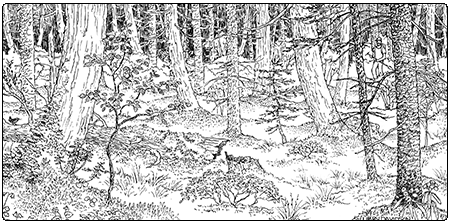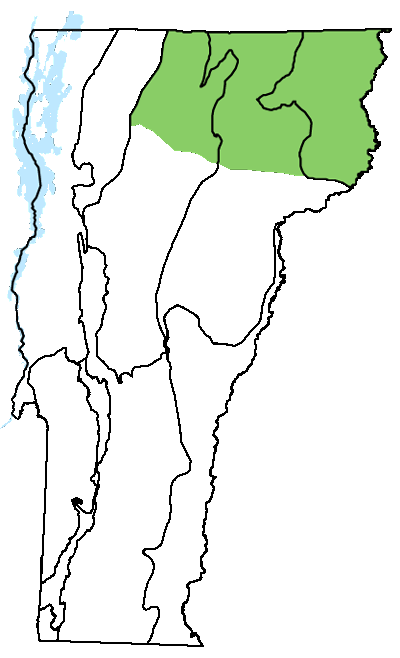Ecology and Physical Setting
In Vermont, northern white cedar is most commonly associated with calcium-rich settings, ranging from dry limestone bluffs to mineral-enriched seepage swamps. But in northeastern Vermont, northern white cedar is also the dominant tree in Boreal Cedar-Sphagnum Basin Swamps—cold, mossy, nutrient-poor places. And cedar can also be present in some Black Spruce Swamps, which are acidic and nutrient poor. In Vermont, it seems that cedar is more competitive on slightly acidic soils in the cold northeastern parts of the state. This pattern, however, is not borne out across the full range of northern white cedar in North America.
Soils in Boreal Cedar-Sphagnum Basin Swamps are permanently saturated with weakly acidic water, resulting in accumulations of moderately decomposed organic soils ranging up to 12 feet deep. Trees are perched on tall hummocks, often surrounded by broad hollows. Sphagnum carpets the hollows, few of which have standing water. These swamps occur in small isolated basins and in larger basins in association with other northern wetland types, including Northern White Cedar Swamp, Spruce-Fir-Tamarack Swamp, and Black Spruce Swamp.
Vegetation

peatlands.
The vegetation in these swamps reflects their boreal and acidic character. Northern white cedar is typically the dominant canopy species, often occurring with black spruce and balsam fir. Black spruce is a co-dominant in some swamps. The cedar trees may be stunted, with highly tapered trunks, but it is common for trees to be 150 to 200 years old in undisturbed swamps. The dense canopy creates a shady understory, except where blowdowns create canopy gaps. As in other cedar swamps, cedar trees that are blown over commonly continue to grow from one or more branches. Cedar regeneration can be abundant.
Typical tall shrubs include mountain holly, wild raisin, and Canada honeysuckle. The heath shrubs velvetleaf blueberry, Labrador tea, and sheep laurel comprise the short shrub layer. Other shrubs include mountain holly, wild raisin, and mountain ash. Typical herbs and low creeping shrubs include three-seeded sedge, creeping snowberry, dwarf raspberry, goldthread, bunchberry, starflower, twinflower, dewdrop, and common wood sorrel. Cinnamon fern may be present or abundant in some swamps. Bryophytes often form a complete carpet, with Sphagnum girgensohnii typically dominant, and Sphagnum centrale and Sphagnum angustifolium also common. Schreber’s moss, three-lobed bazzania, and Sphagnum wulfianum are common associates. Overall, species richness is low.
Wildlife Habitat
In northeastern Vermont, these small swamps are commonly part of a mosaic of coniferous wetlands that provide habitat for several rare bird species, including black-backed woodpecker, Canada jay, rusty blackbird, and yellow-bellied flycatcher. Other breeding birds in Boreal Cedar-Sphagnum Basin Swamps include northern waterthrush and winter wren. The dense cedar canopy provides winter cover, and the twigs and needles provide winter food, for white-tailed deer.
Related Communities
- Black Spruce Swamps are boggy and very acidic, and they are dominated by black spruce. Northern white cedar is absent or sparse.
- Northern White Cedar Swamps have many species associated with groundwater seepage and have high species richness. Black spruce and heath shrubs are absent or sparse.
Conservation Status and Management Considerations
Many of these small swamps are on permanently conserved lands in and around the Nulhegan Basin of northeastern Vermont. Because of deep peat accumulations, spongy carpets of sphagnum, and stunted, slow-growing northern white cedar and black spruce, we recommend that logging not occur in these sensitive wetlands.
Distribution/Abundance
This rare natural community has been identified only from northeastern and north central Vermont. Similar communities occur in New Hampshire, Maine, and Québec.
Characteristic Plants
Trees
Abundant Species
Northern white cedar – Thuja occidentalis
Occasional to Locally Abundant Species
Black spruce – Picea mariana
Balsam fir – Abies balsamea
Tamarack – Larix laricina
White spruce – Picea glauca
Shrubs
Mountain holly – Ilex mucronata
Wild raisin – Viburnum nudum var. cassinoides
Canada honeysuckle – Lonicera canadensis
Velvetleaf blueberry – Vaccinium myrtilloides
Labrador tea – Rhododendron groenlandicum
Sheep laurel – Kalmia angustifolia
Speckled alder – Alnus incana
American mountain ash – Sorbus americana
Bog laurel – Kalmia polifolia
Herbs
Three-seeded sedge – Carex trisperma
Goldthread – Coptis trifolia
Bunchberry – Cornus canadensis
Starflower – Lysimachia borealis
Creeping snowberry – Gaultheria hispidula
Dwarf raspberry – Rubus pubescens
Small cranberry – Vaccinium oxycoccos
Twinflower – Linnaea borealis
Dewdrop – Rubus dalibarda
Common wood sorrel – Oxalis montana
Bluebead lily – Clintonia borealis
Cinnamon fern – Osmundastrum cinnamomeum
Bryophytes
Moss – Sphagnum girgensohnii
Moss – Sphagnum centrale
Moss – Sphagnum angustifolium
Moss – Sphagnum wulfianum
Schreber’s moss – Pleurozium schreberi
Three-lobed bazzania – Bazzania trilobata
Rare and Uncommon Plants
Mountain fly honeysuckle – Lonicera villosa
Dwarf mistletoe – Arceuthobium pusillum
Associated Animals
White-tailed deer – Odocoileus virginianus
Winter wren – Troglodytes hiemalis
Northern waterthrush – Parkesia noveboracensis
Rare and Uncommon Animals
Black-backed woodpecker – Picoides arcticus
Canada jay – Perisoreus canadensis
Rusty blackbird – Euphagus carolinus
Yellow-bellied flycatcher – Empidonax flaviventris
Northern saw-whet owl – Aegolius acadicus
Places to Visit
West Mountain Wildlife Management Area, Maidstone and Ferdinand, Vermont Fish and Wildlife Department (VFWD)
Bill Sladyk Wildlife Management Area, Norton, VFWD
Silvio O. Conte National Fish and Wildlife Refuge, Bloomfield and Lewis, U.S. Fish and Wildlife Service
